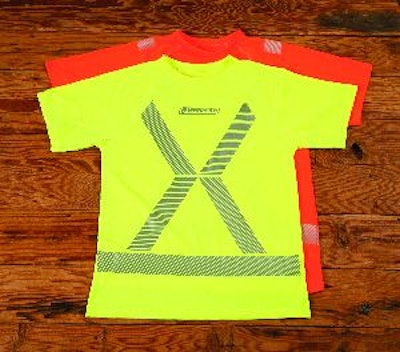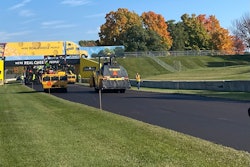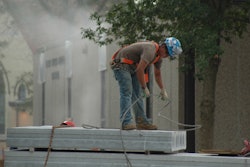
Safety is always an important aspect for anyone working in the construction industry. For pavement contractors whose businesses thrive off road work and maintenance, worker safety is extremely critical. In November of this year, the emphasis on safety will become even more important.
On November 24, 2008, the Federal Highway Administration will require any contractors who are working on or want to bid a job for a federally-funded highway project to follow the American National Standards Institute (ANSI) 107-2004 standard for high-visibility safety apparel.
The ANSI standard, which is voluntary, is meant to help increase the visibility and safety of road workers, says Cory Erickson, market development manager for 3M. The original standard went into effect in 1999 and was revised in 2004. However, starting in November, if contractors hope to work on federally-funded road projects it will be mandatory that all workers be ANSI compliant, Erickson says.
A breakdown of ANSI 107-2004
The ANSI 107-2004 standard breaks safety apparel into three classes based on work environment. Class 1 safety apparel is for workers who have sufficient separation from traffic that is traveling less that 25 mph. The garments that fall into this class are safety vests recommended for sidewalk maintenance workers, workers in warehouses where there is equipment being driven around, and other jobs that are not dealing with much traffic.
Class 2 apparel is meant for poor weather conditions as well as workers near roads where traffic is going 25 mph or faster. These garments are a step up from Class 1 and are often suitable for airport grounds crews as well as people directing traffic in roads or parking lots.
Class 3 is for the highest level of safety for workers in high-risk environments with traffic exceeding 50 mph, which includes roadway construction and maintenance. These garments include pants, shirts, and jackets that provide coverage for most of the body.
The standard also focuses on the material make-up of safety apparel. This clothing is made up of two different materials: a fluorescent material for daytime worker visibility and a retro-reflective material for nighttime worker visibility, according to Erickson. ?It [the ANSI standard] advises the type of background fabric they should have,? he says. ?And it gives the amount that they should have. It also recommends the amount of actual retro-reflective material you should have on,? he says.
The amounts of each material required correspond to the class the safety apparel fits into. If the job dictates a higher class of safety apparel, the standard dictates a larger amount of both materials to be included on the clothing (see ANSI 107-2004 Material Requirements).
Erickson points out that this isn?t a standard specific to safety vests. It is meant for all safety apparel. This is important because Erickson says the industry trend is moving from vests to more comfortable clothing such as T-shirts. The use of this clothing has multiple benefits. Because it is more like regular clothing it is more comfortable for workers who must where it.
The trend of primary apparel
Reade Simonds, director of apparel for Ironclad Performance Wear, confirms that the safety apparel market is moving in the direction of more comfortable work wear. ?Ability is key,? Simonds says. ?We know that they?ll perform better if they?re warmer, or if they?re cooler, or if they?re not as sweaty. They?re going to perform better on their job.?
Ironclad has jumped right into this growing trend. About two years ago the company moved into the apparel market, Simonds says. Since then, Ironclad has been looking at new ways to manufacture more comfortable work wear. ?Looking at all performance driven fabrics, more durability, anti-microbial, range of motion - these are all things we?ve been working on.?
Ironclad manufactures a range of apparel including, pants, jackets, polo shirts, and more. The new I-Viz collection was created for working conditions where high worker visibility is necessary. ?Our I-Viz collection is based on ANSI standards, whether it?s the reflective tape and the amount of inches required or the color standards required by the safety industry,? Simonds says. Ironclad?s I-Viz collection meets ANSI Class 2 standards, which is the lowest class to satisfy compliance with the new FHWA rule.
3M - which supplies retro-reflective tapes and materials to the market place - is also contributing to the comfort movement in safety apparel through its Comfort Trim product line, according to Erickson. ?Instead of a solid strip of retro-reflective material, which has been the standard, it?s a segmented strip so it breathes. It allows moisture vapor to transmit through the actual trim. So not only is the T-shirt more comfortable but the actual trim that goes on there breathes more like the T-shirt does,? he says.
Simonds says the new FHWA requirement is a positive thing for the construction and safety apparel industries. ?The more visibility to drivers driving on these highways under construction, the better off these workers are going to be.? An extra benefit Simonds sees from the growing trend in safety apparel is that the new, more comfortable apparel is not necessarily task specific. This clothing can be worn both on and off the jobsite. Instead of being only for the job it can serve as everyday clothes.
The FHWA?s requirement
So now that you know more about the ANSI 107-2004 standard as well as the safety apparel options available, it?s time to focus on what the November deadline means for pavement and pavement maintenance contractors.
The ANSI standard will still remain a voluntary standard, except for projects on federal roads that use federal aid. The Federal Highway Administration (FHWA) has approved a new part to title 23, Code of Federal Regulations (CFR). Part 634 is what will come into effect in November. According to Part 634, the purpose of this new regulation is to decrease chances of worker fatalities or injuries from motor and construction vehicles while working on highways.
The exact FHWA rule reads, ?All workers within the right-of-way of a Federal-aid highway who are exposed either to traffic (vehicles using the highway for purposes of travel) or to construction equipment within the work area shall wear high-visibility safety apparel.?
The FHWA ruling says that all workers involved in this type of project must wear safety apparel that meets either Class 2 or Class 3 requirements of ANSI 107-2004.
Contractors who want to bid on projects with federal funds must then require all workers as well as all subcontractors and their employees working on the job to wear the required Class 2 or 3 safety apparel, Erickson says. If a contractor refuses to comply, he is unlikely to get the job.


















